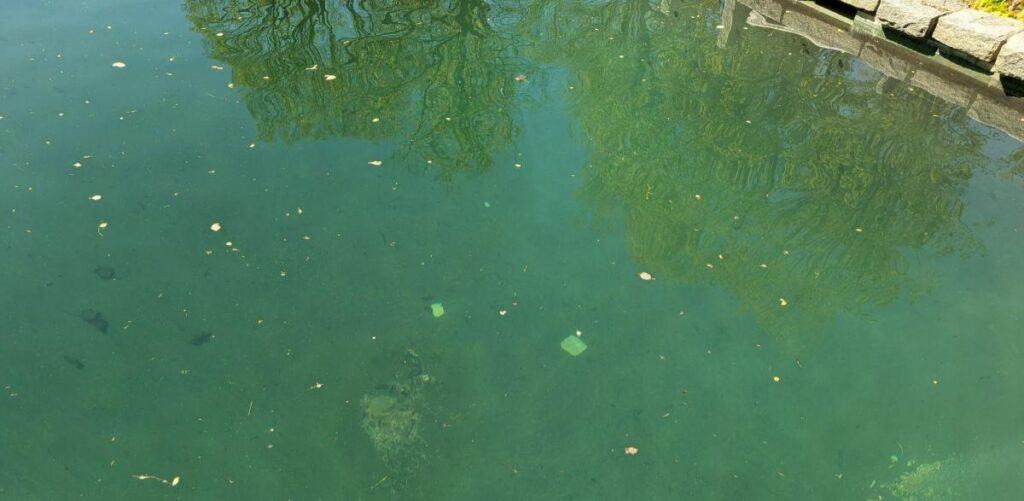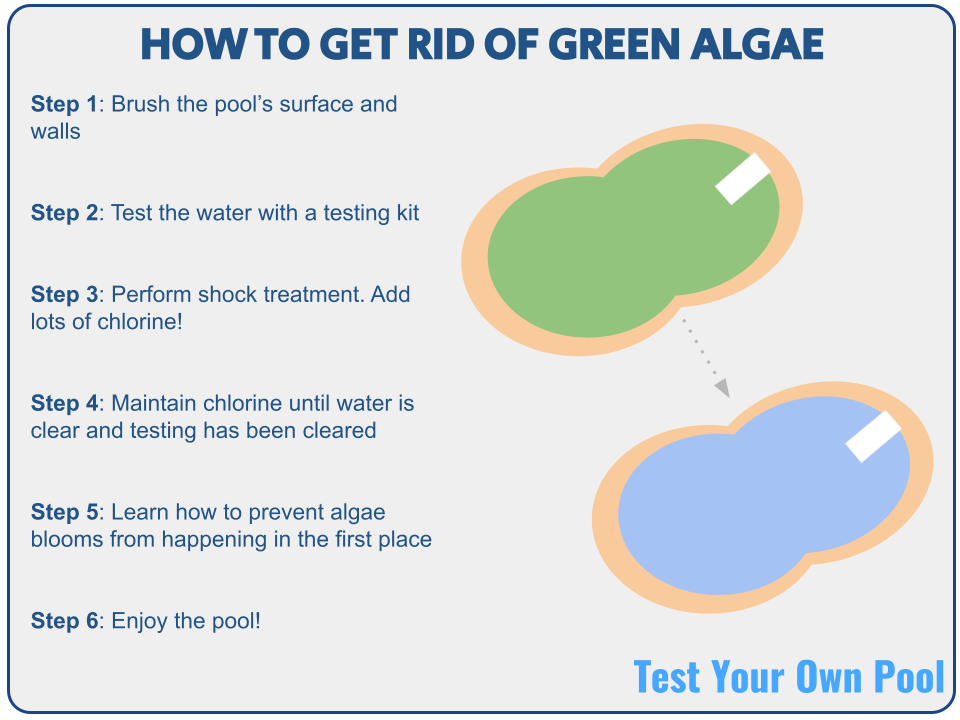If you wake up one morning and find yourself looking at a green pool, don’t panic too hard. It could just be settling debris, but most of the time, it is green algae.
However, if any problem is a “good” problem, green algae is better than mustard algae. The good news is this problem can be handled with a plan of attack.
What is Green Algae?
Before any battle, it’s important to understand the enemy and how it got here in the first place.
Simply put, green algae is a living organism that grows in various bodies of freshwater like lakes, creeks, and, yes, swimming pools.
It usually starts to form cloudlike shapes in the water that turn it into a murky green. It usually floats in the pool but can also stick to surfaces and walls making them pretty slippery.

There are various stages of “green” for this type of algae. A lighter green indicates an algae bloom that has just started. The darker the green, the more algae in the pool.
What Causes Green Algae?
As mentioned above, green algae tends to grow in freshwater. It can get into a pool by the wind, rain, warm water temperatures, and even from contaminated swimwear!
The most common cause of green algae blooms is a lack of chlorine or sanitizer, causing unbalanced water.
Chlorine’s main job is to kill and prevent organisms from growing. When there is little to no chlorine in the water, algae can grow unimpeded.
Poor circulation and filtration of the water can also cause green algae issues to pop up.
How to Get Rid of Green Algae In Your Pool
What it boils down to is this: the best and most effective treatment for killing green algae in your pool is throwing a bunch of chlorine at it.
We want to increase our free chlorine (FC) levels and maintain them until the algae have been completely killed off. This is known as shocking your pool.
Follow these steps closely, and most importantly, do not stop until the algae is completely cleared from your pool’s water!
Before we start, it’s important that there is someone around at all times to monitor and complete the process below. This process may take a few days to complete.

Frequently Brush the Pool
Brushing the pool disturbs any green algae spores that might have started to cling to the surface of the pool.
The overall goal here is to get the algae floating in the water so the chlorine can do its work and the filter can start to catch it.
18" heavy-duty brush with nylon bristles to clean pool walls, tiles, and floors.
Brushing should be done frequently throughout the whole process. Algae is very stubborn, so the more it gets disrupted, the quicker it can be cleared.
You may also need to remove any lighting fixtures as algae can find its way behind the lighting niche.
Test the Pool
A complete pool test should be done to get a baseline of where we are and what needs to be done.
As always, test reliability is key here. It’s especially important when fighting an algae outbreak because this process can take days to complete. The numbers need to be as accurate as possible so we can put in the right dosage of chemicals.
Otherwise, we risk having to start the process over again in a week. Therefore, a FAS-DPD testing kit is highly recommended.
The most accurate and reliable pool testing kit.
Type of Chlorine Test: FAS-DPD
Read our full Taylor K-2006 Review.
Keep the Pump Running
As we brush and clear up the water, the filter must catch as much green algae as possible. Having the pool pump constantly running can help speed up algae removal significantly.
When you start to notice the filter struggling and the water not circulating as effectively, either backwash or clean the grids, depending on what type of filter you have.
A lot of algae may require multiple filter cleanings during the whole process.
Prepare for Chlorine Additions
The two main parameters we want to look at are pH and CYA.
We want pH levels around 7.2 to 7.4 to accommodate the high chlorine levels. Anything above 10 ppm FC makes pH testing unreliable, so keeping it at the lower end is recommended.
Also, keep in mind that total alkalinity (TA) can affect pH balance, so make sure it is at a recommended level between 50 to 90 ppm (further understand TA levels).
Lastly, for this process to work properly an accurate CYA reading is crucial. This will determine how much chlorine we need to add. The higher the CYA, the more chlorine we need.
Run a Pool Shocking Treatment
“Shocking” the pool is just a process of increasing chlorine levels to kill any contaminants or organisms. You might see pool shops or big box stores selling pool shock, but that is usually just calcium hypochlorite, otherwise known as cal hypo.
That said, we will want to shock the pool until the algae has been cleared. It is highly recommended to use liquid chlorine as we will need a lot during the process.
Cal hypo is a good substitute, Just note it will also increase calcium hardness (CH).
Find the correlating FC level based on CYA. We need to maintain this level for the duration of the process. It may seem overkill, but algae does not go away that easily.
According to Richard Falk, an approximate shocking range is about 40% of your CYA level, which would be the following:
| CYA (Stabilizer) | FC to Shock Level |
|---|---|
| 20 | 10 |
| 30 | 12 |
| 40 | 16 |
| 50 | 20 |
| 60 | 24 |
| 70 | 28 |
| 80 | 32 |
| 90 | 36 |
| 100 | 40 |
Continue Shock Treatment Until the Pool Clears
As stated above, algae clearing may go well beyond a few days. The more vigilant we are in maintaining that FC level, the quicker and more effectively the chlorine will work.
As the chlorine does its thing, continue brushing and filtering the water. Feel free to also vacuum to waste if you can afford to reduce some water.
Day by day, the water should get more clear as the algae continue to die and get filtered out. The light is at the end of the tunnel!
How to Know When the Algae is Clear
Some criteria need to be passed to ensure the algae is gone and it is safe to swim again:
- The water is clear: At this point, your pool should have crystal-clear water with no visible signs of algae on the floors, walls, ladders, steps, or anywhere! This includes algae that is both dead and alive. Basically, it should be at its “normal” look and feel.
- Combined chlorine (CC) is less than 0.5: Combined chlorine (CC), or chloramines, measures how much “bad stuff” is still in the water. When CC is 0.5 or below, it is safe to assume there are no more contaminants. Anything above that means the fight is not yet over.
- FC is maintained overnight: The last test is to check FC levels overnight. Chlorine is consumed by two items: organic compounds and sunlight. We want to eliminate the sun as a potential factor for chlorine loss, so this should be done overnight. After the sun goes down, record FC levels. Then, before the sun rises, record FC again. If FC levels decrease by 1 ppm or lower, water is clean. If not, we continue fighting.
It might seem that the pool is free of algae just by looking at it, but testing will make it absolutely clear. The last thing we want is to think that we are down only for the algae bloom to reappear in a few days.
How to Prevent Green Algae in Your Pool
Let’s face it: that process is not fun. Whether you’ve dealt with green algae issues and are looking to prevent it from happening again, or never want it to happen in the first place, follow some of the basic pool testing and maintenance guidelines:
- Test your water frequently: Testing is the only way to know if there is an issue with your pool’s water. Seeing an issue means it is too late. The more frequent testing is done, the more preventable a water outbreak can be.
- Maintain proper water chemistry: After testing, ensure that all chemistry parameters are balanced and at the recommended levels.
- Keep the water circulating: Run your filter and pump as long as you can. It should be running at least 8 hours a day, especially during the hottest parts.
- Brush and vacuum weekly: A routine brushing and vacuuming will help to disturb any contaminants that may be on the walls or floors.
Read This Once, and Then Never Again!
Hopefully, the goal of this page is to be seen once. Prevention and maintenance is key.
If you did happen to read this because of an outbreak, just think about how much you are going to enjoy a dip once it has finally cleared up.


